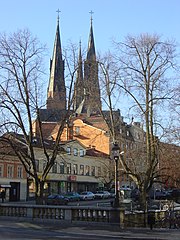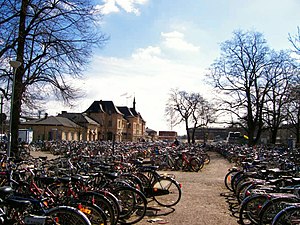Uppsala [ˈɵpˌsɑːla] (older spelling Upsala) is a city in central Sweden, located about 70 km north of Stockholm. It is the fourth largest city in Sweden with its 130,000 inhabitants; including immediate surroundings, Uppsala Municipality amounts to 183 403 (2005).
History


Uppsala was originally located a few kilometers to the north, at a location now known as Gamla Uppsala (Old Uppsala). Today's Uppsala was then called Östra Aros. (Old) Uppsala was, according to medieval writer Adam of Bremen, the main heathen centre of Sweden, and the Temple at Uppsala contained magnificent idols of the Æsir gods.
As a replacement for the Scandinavian gods, Uppsala was made into a strong Christian centre. A bishop was soon consecrated, and in 1164 Uppsala was made into an archdiocese, with Stefan, a monk from Alvastra Abbey, being consecrated the first Archbishop of Uppsala and primate of Sweden.
The present-day Uppsala was at that time known as Östra Aros and was a port town of Gamla Uppsala. In 1274, Östra Aros overtook Gamla Uppsala as the main regional center, and when the cathedral of Gamla Uppsala burnt down, the archbishopric was moved to Östra Aros, and the impressive Uppsala Cathedral erected.
Uppsala is the site of the oldest university in Scandinavia, founded in 1477. Carolus Linnaeus, one of the renowned scholars of Uppsala University, lived in the city for many years, and both his house and garden can still be visited. Uppsala Cathedral is built in the Gothic style and is one of the largest in northern Europe, with towers reaching 118 metres. Uppsala is also the site of the 16th century Uppsala Castle.
The city was severely damaged by a fire in 1702. Historical and cultural treasures were also lost, as in many Swedish cities, from demolitions during the 1960s and 1970s. Despite the lack of understanding of the value of the older buildings at that time, many historic buildings remain, especially in the western part of the city.
The arms with the lion can be traced from 1737. It has been modernized several times since, most recently in 1986. The meaning of the lion is not certain but is likely connected to the royal lion, also depicted on the Coat of Arms of Sweden.
Politics
Historically, Uppsala Municipality has been a centre both of conservatism and liberalism, both receiving their ideological nourishment from the University. Today, however, the city is divided between left and right and has since 1994 been governed by a coalition of the Social Democrats, the Left Party and the Green Party until the 2006 elections where the centre-right coalition Alliance for Sweden won not only the national elections but also the regional.
The Livets Ord evangelistic church is based in Uppsala.
Geography
Situated on the fertile Uppsala flatlands of muddy soil, the city is featured by the small Fyris River (Fyrisån) flowing through the landscape surrounded by lush vegetation. Parallel to the river runs the glacial ridge of Uppsalaåsen, at an elevation of circa 30 metres the site of Uppsala's castle from which large parts of the town can be seen. The central park Stadsskogen stretches from the south far into town, with opportunities for recreation for many residential areas within walking distance.
Only some 70 kilometers or 40 minutes by train from the capital, many Uppsala residents work in Stockholm. The train to Stockholm-Arlanda Airport takes only 17 minutes, rendering the city easily accessible by air.
The commercial centre of Uppsala can best be described as quite compact: While some beautiful buildings remain in the periphery of the central core, especially on the less intensively built western river bank around the cathedral, castle and university, retail commercial activity is geographically focused to a minor number of blocks around the pedestrianized streets and main square, an area which was subject to large-scale post-World War II metamorphosis during the economically booming years in the 1960s in particular. During recent decades, a significant part of the retail commercial activity has been relocated to shopping malls and stores situated in the outskirts of the city. Alongside with this, the built up areas have expanded in a quite extensive way, and a certain suburbanization has taken place.
Economy

Today Uppsala is well established in medical research and recognized for its leading position in biotechnology.
- GE Healthcare
- Pfizer (see Pharmacia)
- Fresenius
- Slotts (food manufacturer, including mustard)
- Lindvalls kaffe (coffee manufacturer)
- Headquarters of MySQL AB
- Q-Med (bioscience)
Universities
- Uppsala University. Founded in 1477, under bishop Jakob Ulvsson. Closed in 1515. Officially reopened in 1595, following the Uppsala Synod in 1593. The university has a famous anatomical theatre, constructed by the scientist and polymath Olof Rudbeck (1630-1702), in the old university building Gustavianum. Nowadays the building is a museum. The University has 13 student nations each representing a geographical region of Sweden.
- Swedish University of Agricultural Sciences (SLU, Sveriges Lantbruksuniversitet, main campus)
Sites of interest
The Fyris river neatly divides the city into two different parts: the historic quarter to the west of the river and the administrative, residential and commercial area to the east. Most of the features of interest are in the western part, dominated by the cathedral, and with its old streets, river views and parks.
The most outstanding building in Uppsala is the Domkyrka (Uppsala Cathedral), Scandinavia's largest church (118.70m high), which is visible from most parts of town.
Facing the west end of the cathedral is the Gustavianum, built in 1625 to be the main building of the University, and served as such through most of the 19th century. It contains the Museum of Nordic Antiquities, the Victoria Museum (of Egyptian antiquities) and the University's cultural history collections. It also houses a perfectly preserved 17th-century Anatomical Theatre (used in its time for public dissections).
Across the street from the Gustavianum stands the new building of the Uppsala University, erected in 1879-86 in Italian Renaissance style.
Not very far from the University stands the Uppsala University Library (Carolina Rediviva), also the largest library in Sweden, with over 2 million volumes and some 30,000 manuscripts. The building was built in 1820-1841.
On a circa 35-metre high hill to the southwest of the University Library stands Uppsala Castle. Its construction was initiated in 1549 by King Gustav Vasa, founder of the modern Swedish kingdom. Today the castle holds several museums.
5km north of Uppsala lies Gamla Uppsala (Old Uppsala), the location of the medieval village of Uppsala. There are few remains, with the exception of three huge burial mounds of pre-Christian monarchs and a 12th-century church.





No comments:
Post a Comment